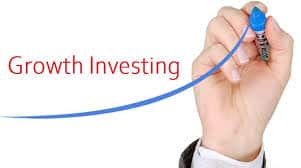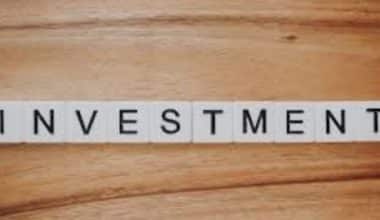It’s common for investors in the growth sector to hunt for companies that are developing new products and services in fast-growing industries. However, investing for beginners can be quite tricky. Before making any sort of investment, you should learn more about growth investing with value (value vs. growth), income, or dividends.
Growth Investing
Growth investing is a type of investing that aims to increase an investor’s capital. In other words, growth investing is a method for choosing stocks to buy based on their underlying businesses’ long-term expansion potential.
Growth investors often trade in growth stocks, which are new or tiny companies with earnings that are predicted to rise at a faster rate than the industry sector or the broader market. Also, Growth investors place a greater emphasis on a company’s future potential than on its current financial indicators or fundamental market value. Growth investing is seen as a more aggressive investment strategy than value investing. Growth equities have generally performed better when interest rates are low or dropping and corporate earnings are increasing.
The Dangers of Growth Investing
Most growth stocks trade at high valuations compared to their current businesses because they price in future growth prospects.
Even earnings growth that might otherwise impress Wall Street might disappoint growth stock investors and lead to a sell-off if a growth stock’s pricing already incorporates expectations for strong future growth numbers. Growth investors can sell stock all at once if it exhibits symptoms of slowing or stalling growth, causing a rapid fall.
Increasing interest rates are also seriously damaging to growth stocks. When the discounted interest rate is greater, fund managers sometimes utilize discounted cash flow models to value future cash flows at a lower rate. In other words, the lower the discount rate, the higher the current value of future cash flows.
Now, let’s take a closer look at the processes required to completely capitalize on growth investing now that you’ve decided it’s right for you.
Step 1: Get your Finances in Order
A solid rule of thumb is to avoid buying stocks with money you won’t have for at least the next five years. That’s because, while the stock market normally grows over time, it frequently experiences abrupt declines of 10%, 20%, or more without warning. Putting yourself in a position to be compelled to sell stocks during one of these down times is one of the biggest blunders you can make as an investor. Instead, you should be prepared to buy equities when the majority of others are selling.
Step 2: Become Familiar With Various Growth Strategies.
Now that you’ve taken the first steps toward a more secure financial future, it’s time to empower yourself with yet another powerful tool: information. After all, there are a variety of growing investment options from which to pick.
It’s common sense to concentrate your purchasing on industries and brands you’re familiar with. That information can help you analyze assets as potential buy candidates, whether it’s because you’ve worked in a restaurant company or for a cloud computing services company. It’s usually better to know a lot about a small group of companies than to know a little about a large variety of companies.
Step 3: Choosing a Stock
It’s now time to get ready to start investing. The first step in this process is to determine how much money you want to put into your growth investment strategy. If you’re new to the strategy, it’s a good idea to start modest, perhaps with 10% of your portfolio’s funds. This ratio can rise as you become more comfortable with the volatility and gain experience investing in a variety of markets.
Growth stocks are deemed more aggressive, and consequently more volatile than defensive equities, so risk plays a large factor in this decision. As a result, a longer time horizon gives you greater leeway to skew your portfolio toward this investing strategy.
If your portfolio makes you nervous, it’s a solid indicator that you have too much of a growth stock allocation. If you’re concerned about possible losses or are concerned about prior market dips, you might wish to diversify your portfolio and limit your exposure to individual growth stocks.
Investing In Growth Funds
A fund is the simplest approach to obtaining exposure to a diversified variety of growth stocks. Many retirement plans offer growth-oriented choices, which could be the foundation of your investment strategy.
Consider investing in a growth-oriented index fund. Index funds are an excellent way to invest because they provide diversity at a cheaper cost than mutual funds. This is because, in contrast, mutual funds, which are managed by investment managers who strive to outperform the market, index funds merely match the return of the industry benchmark. Because most investment managers fall short of that standard, an index fund will usually put you ahead of the game.
Step 4: Increase Your Profits
Larger stocks are incredibly fickle, and just as you should attempt to keep each investment for at least a few years, you should keep a keen eye on big price movements for a few factors.
- When a section of your investments has grown in value to the point where it now controls your portfolio, adjusting your portfolio may be a good way to lessen your exposure.
- When a stock’s price climbs much over your estimation of its value, you should think about selling it, especially if you have an alternative, more fairly priced purchase in mind.
- If indeed the company has encountered a snag that contradicts your initial investment idea or the purpose you buy the shares in the first place, you should consider selling. Major management blunders, a long-term decline in pricing power, or disruption by a lower-priced competitor are all examples of a shattered thesis.
These are just a few of the many reasons why an investor would wish to sell a stock and make changes to their portfolio.
Dividend Growth Investing
With dividend growth investing, investors want to invest in dividend-paying stocks. Which is issued by firms that boost their dividend rate per share given to stockholders on a regular basis.
Why Should You Go For Dividend Growth Investing in Stocks?
Here are five compelling reasons to begin executing a dividend growth investing strategy.
- Look For And Recognize Dividend Growth Stocks
- Pick The Best Dividend-Paying Stocks And Buy Them
- How To Put Together A Dividend Growth Portfolio
- Keep an eye on your dividend stock portfolio on a regular basis.
- Reinvest all dividends until they are required.
Consider dividend growth investing in stocks, ETFs, and mutual funds even more. They can help you save time when it comes to putting together and maintaining a dividend growth portfolio.
Dividend Growth Investing Has a Number of Advantages.
Finally, there are numerous benefits to pursuing a dividend growth investing plan. Here are a few merits to investing in dividend growth.
- Dividends account for a significant share of stock market returns.
- Dividend growth stocks have a high total return on investment.
- Dividend reinvestment increases your return on investment.
- The majority of the income comes from a passive investment technique.
- Dividends can be used to supplement retirement income.
- Dividends that are increasing provide a hedge against inflation.
- Even if the stock market is down, you can still get dividends.
What Is a Dividend Growth Investing Strategy and How Does It Work?
Dividend growth investing is divided into five parts. These are the steps:
- Find and recognize dividend-paying stocks that are growing in value.
- Choose and purchase the top dividend- growth-paying investing stocks.
- Make a dividend growth investing portfolio out of the equities.
- Keep an eye on your dividend growth stock portfolio on a frequent basis.
- All dividends should be re-invested until you need them.
Value vs Growth Investing
There are two types of investments: value and growth investing. Value stocks typically offer the option to purchase shares at a discount to their current value, while growth stocks have above-average profit and income growth potential.
Many people believe that growth and value investing are diametrically opposed strategies, which is why there is a comparison (value vs growth Investing) between them. Value investors look for “value stocks” that sell at a discount to their actual or book value, whereas Growth investors, although considering a company’s underlying worth, prefer to overlook traditional signs that signal the stock is overvalued.
While value investors are looking for stocks that are trading for less than their inherent value today, growth investors are more concerned with a company’s future value than with its current stock price. Growth investors, as opposed to value investors in (value vs growth Investing), may purchase stock in firms that are trading at a premium to their intrinsic value with the expectation that the underlying value will rise and eventually surpass present prices.
Those interested in learning more about growth investing, value investing, and other financial issues should enroll in one of the best investing courses available today.
Value vs Growth Investing: Growth Stocks
Small, up-and-coming enterprises are prioritized by growth companies as they strive to become industry leaders as rapidly as feasible. Early on, these businesses focus on increasing sales, which often comes at the expense of profitability. After a period of time, growing companies begin to place a greater emphasis on profit maximization.
The company’s perceived worth grows in the eyes of growth-oriented investors when those key financial measures improve. As a result, a positive feedback loop may emerge. A company’s image can be boosted by a growing stock price, which can help it win more business.
As assessed by price-to-earnings or price-to-book value ratios, growth stocks have very high values. They do, however, see faster revenue and income growth than their counterparts.
Value vs Growth Investing: Value Stocks
Value stocks are publicly traded firms that sell at low prices compared to their earnings and long-term growth prospects. These value stocks aren’t known for their explosive rises. Value stocks are characterized by stable, predictable business models that provide modest sales and earnings growth over time. You might sometimes locate value stocks in companies that are in a downturn. Their stock price, however, is so cheap that it undervalues their future earning potential.
Value vs Growth Investing: Which Is More Important, Growth or Value?
Both growth and value stocks (value vs growth investing) provide investors with profitable investment options. Your personal financial goals and investing preferences will determine which investment type is ideal for you.
Value vs Growth Investing: Growth Stock
If any of the following applies to you, growth stocks are more likely to appeal to you:
- You’re not interested in your portfolio’s present income. The majority of fast-growing corporations do not pay big dividends to their owners. This is because they choose to reinvest all available cash back into their business in order to generate faster growth.
- You’re at ease with large stock price swings. A growth stock’s price is very sensitive to changes in a company’s business prospects in the future. Growth stocks can be beneficial when things go better than predicted. Larger growth stocks can drop to the ground just as swiftly as lower-priced growth companies when they fail.
- You’re able to have the ability to predict victors in emerging markets. You can find growth stocks frequently in fast-moving sectors of the economy, such as technology. Many various growth companies fight against each other on a regular basis. You’ll need to identify as many future finalists as possible in a certain industry while avoiding losers.
- You’ll have plenty of time to get your money back before you need it. Growth stocks can take a long time to reach their full potential, and they frequently experience setbacks. It’s vital to have a long enough time horizon to allow the business to flourish.
Value vs Growth Investing: Value Stocks
If you look for these features in value stocks, they may appear more appealing:
- You’re looking for a steady stream of income from your investment portfolio. Many value stocks pay out large amounts of money in dividends to their stockholders. Because such organizations lack considerable development potential, they must find other ways to keep their stocks appealing. One strategy to entice investors to look at stocks is to pay out attractive dividend payouts.
- You want stock prices that are more consistent. Value stocks aren’t known for having huge price swings either way. Stock price volatility is usually modest as long as their business circumstances remain within predictable ranges.
- You’re certain you’ll be able to avoid value traps. Stocks that appear to be bargains are frequently value traps or bargains for a reason. It’s possible that a business has lost its competitive advantage or is unable to keep up with the pace of innovation. To see whether a company’s future business prospects are weak, you’ll need to be able to look past its enticing values.
- You desire a faster return on your investment. Value investments aren’t going to make you rich overnight. A company’s stock price might quickly grow if it is successful in getting its business moving in the correct way. The finest value investors spot stocks that are undervalued and buy shares before others do.
Income vs Growth Investing
The basic goal of income investing is to find investments that will provide a consistent stream of passive income. Growth investing, on the other hand, places a premium on assets that will increase in value over time. also To choose between income and growth (income vs growth) investing, you must first define your investment objectives and risk tolerance. On the other hand, stocks and ETFs are among the most popular investments. Regardless of the strategy you choose, Just remember to make your investment fees as minimal as possible.
To begin with, what exactly is an investment strategy? It is a well-defined method of investing. It aids in the decision-making process for an investor’s investment portfolio. It’s alluring to go after the newest hot investment without a plan for investing. which is frequently a recipe for poor investment performance.
Before we comparing between income vs growth investing, we will start by understanding their different definitions.
Income vs Growth: What Is Income Investing?
An income investment strategy’s primary goal is to provide a steady stream of income. The income is distributed to the investor. Interest, dividends, and rents are all examples of how it is paid.
This type of income is sometimes referred to as “portfolio income.” because it is derived from a portfolio of income-producing assets.
Income vs Growth: What Is Growth Investing?
Growth investing, on the other hand, focuses on capital appreciation. To put it another way, increasing the value of an initial investment
Additionally, investors that use this strategy seek out investments that show evidence of quick growth. either by increased revenues, profits, or capabilities with a far higher future value.
Another strategy, in contrast to a value, investing, Even if the price appears to be excessive, growth investments are occasionally made.
Lastly, growth investments can generate revenue under specific circumstances. However, earning money is not the primary goal. It’s just a bonus of investing for long-term growth.
Income vs Growth: How Does Income Investing Work?
To begin, an income investing plan entails purchasing revenue-generating assets. And putting them in a portfolio of income investments. To generate monthly investment income. The goal is to generate as much cash flow as feasible. This is in line with the investor’s risk tolerance.
Once the income from each income investment has been received. It is the investor’s right to do anything they choose with their earnings. The choices are straightforward. Spend it, save it, or put it back into the market.
Furthermore, after an investment’s income is received. The owner will never be able to get it back.
Finally, the value of the assets in the affordable portfolio will change. In the long run, hopefully, the values will rise. However, this is not always the case. Not for every income-generating asset, either. An income investor, on the other hand, wants his or her investments to grow in value. A secondary goal is to be appreciated. It is, nonetheless, a significant one. And it should not be neglected while making income investment options.
Finally, you’ll have a consistent source of investment income. There isn’t much of a need to sell assets. Unless they find their best price. Alternatively, the income portfolio may need to be rebalanced. For the sake of diversification.
Income vs Growth: How Does Growth Investing work?
A growth investing approach, on the other hand, involves purchasing assets that are predicted to appreciate in value. These assets are held in a portfolio of growth investments. The goal is to increase the value of the initial investment as much as possible. This is in line with the investor’s risk appetite.
Growth unlike income in investing, when comparing between income vs growth must sell assets. If he or she needs to earn money for investment. After that, it’s your turn. What’s the difference between income and growth (Income vs Growth) investing? To answer this question, let’s look at some cases where
Income vs Growth: Income Investing Examples
These are a few income investing examples. These are the types of investments that a typical income investor would purchase and hold in their portfolio. However, there are many more, but I’d like to focus on a few of the most popular ones.
#1. Accounts with a high return on investment.
This is a type of savings account that is mostly offered by banks. In most cases, your savings are insured against loss. And in exchange for your financial assistance. You earn money via interest.
#2. Bonds.
A fixed-income investment is a bond. An investor lends money to a company. For example, a firm, government, or initiative that borrows money at a fixed rate of interest for a set length of time.
#3. Dividend stocks
They are shares of common stock that give you a piece of the firm. Dividend investing vs. growth investing refers to when a corporation pays dividends to its owners on a regular basis.
#4. REITs
They are a type of real estate investment trust (REITs). Another sort of dividend-paying stock is real estate investment trusts (REITs). To qualify for this period, the corporation must own, finance, or manage income-producing real estate.
#5. ETFs
(Exchange-Traded Funds) are a type of mutual fund (ETFs). A mutual fund that monitors an underlying index is known as an exchange-traded fund (ETF). The index will be focused on income-producing securities in this situation. Dividend stocks or bonds, for example.
#6. Real estate property
that can be touched. Rental properties are the most common physical real estate investment for income investors.
If you’d like to learn more about these and other income investments, please contact us. Check out my comprehensive guide to investing in income assets.
Income vs Growth: Growth Investment Examples
The following are a few instances of growth investment: These are the investment options that a growth investor would typically purchase and keep in their portfolio. There are many more, but I’d like to focus on a few of the most popular ones.
The Most Popular Investments for Growth
Growth stocks are shares of common stock that reflect a portion of a company’s ownership. Furthermore, company management chooses to reinvest the majority of profits, if not all, back into the company.
Private companies. owning a stake in a company that isn’t listed on a public stock exchange. Profits are preserved and re-invested in the company once more.
ETFs (Exchange-Traded Funds) are a type of mutual fund (ETFs). An ETF, as we all know, is a group of securities that track an underlying index. The ETF index is focused on growth stocks or other sorts of growth assets in this situation. This has little or no payoff.
Real estate. Undeveloped land, for example, is not currently positioned for rental income. It’s a physical asset that’s being held because of its potential for expansion.
Increasing The Number of Speculative Growth Investments
Precious metals are metals that have a high value. Popular investment metals include gold, silver, and platinum. They do not pay any money to the owner.
Currencies. The rules of supply and demand influence the value of a currency, just as they do other appreciating assets.
Gems, collectibles, and high-end stuff. Only one’s imagination can limit the variety of luxury assets that fit under this category. However, the value is solely determined by what another party is willing to pay. Unusual investment assets include classic cars, wine, baseball cards, and stones such as rubies.
As you go over the list of probable growth investments above, keep this in mind. They get more speculative as time goes on. As a result, the investment returns could be significant.
However, you must be knowledgeable in the field. To deal with the danger Also, understand how to purchase low and sell high.
That’s why the majority of growth investors stick to the most well-known categories. Specifically, growth stocks, private enterprises, exchange-traded funds (ETFs), and real estate. when there is sufficient information to determine the quality of each investment.
Income vs Growth: Identifying A Company’s Growth Investing Potential
Growth investors are interested in the potential for a company or a market to grow. There is no exact formula for assessing this potential; it necessitates a degree of personal interpretation based on objective and subjective elements, as well as personal judgment. Certain methodologies or criteria may be used by growth investors as a foundation for their studies, but these methods must be applied with the company’s specific conditions in mind. In particular, its current position in relation to previous industry performance and financial performance.
In general, however, when evaluating companies that may deliver capital appreciation. These are some of them:
#1. Strong Earnings Growth in the Past
Over the previous five to ten years, companies should have demonstrated robust earnings growth. The minimum earnings per share (EPS) growth depends on the company’s size; for example, companies with revenues of more than $4 billion should expect growth of at least 5%, and companies with revenues of $400 million to $4 billion should expect growth of 7%, and companies with revenues of less than $400 million should expect growth of at least 12%. The underlying premise is that if a company has shown strong growth in the recent past, it is likely to do so in the future.
#2. Strong Earnings Growth in the Future
An earnings announcement is a public indication of a company’s profitability for a specified time period, usually a quarter or a year. During earnings season, these announcements are made on certain days and are preceded by earnings estimates released by equity analysts. Growth investors pay close attention to these projections as they try to figure out which companies are expected to grow faster than the sector average.
#3. Profit Margins That are Strong
The pretax profit margin of a corporation is computed by subtracting all expenses (excluding taxes) from sales and dividing by sales. It’s a vital indicator to analyze because a company’s sales growth can be outstanding, but profitability growth can be poor, indicating that management isn’t controlling costs and revenues. In general, a company may have promising growth potential if its pretax profit margins exceed its prior five-year average, as well as those of its industry.
#4. Strong Return on Investment (ROE)
The return on equity (ROE) of a corporation assesses its profitability by demonstrating how much profit it earns with the money invested by shareholders. Net income is divided by shareholder equity to arrive at this figure. A decent rule of thumb is to compare a company’s current ROE to the company’s and industry’s five-year average ROE. If the ROE is stable or improving, management is doing a good job of generating returns from shareholders’ capital and running the business efficiently.
#5. Stocks are Performing Well.
In general, a stock isn’t a growth stock if it can’t reasonably double in five years. Keep in mind that a stock’s price would double in seven years if it grew at a 10% annual pace. For a company to double in five years, it needs to grow at a pace of 15%, which is absolutely doable for fledgling enterprises that are quickly expanding industries.
Is Growth Investing Good?
Stocks with high potential for future growth are generally predicted to beat the market in the long run. Many investors believe that value stocks offer a discount to their true value. Whether an investor should pursue a growth stock or value stock strategy depends on factors such as the investor’s risk tolerance and time horizon.
How Risky Is a Growth Fund?
Investors with a lengthy time horizon and a high tolerance for risk can choose growth funds, which tend to be high-risk but potentially high-reward.
When Should I Invest in Growth Stocks?
If interest rates are falling and corporate earnings are increasing, growth stocks may see a positive return on investment.
What Is High Growth Investing?
A high-growth investment type places an emphasis on price appreciation in your investment. You must have a threshold for pain and unpredictability because this sort of investing frequently carries a high level of risk. Usually, investors using a growth strategy are unable to obtain their money right away.
Is Growth Investing Better?
Yes, growth investing is better than value investing. Because, value stocks typically offer the option to purchase shares at a discount to their current value, while growth stocks have above-average profit and income growth potential.
What Are Examples of Growth Investments?
These are the investment options that a growth investor would typically purchase and keep in their portfolio
- Growth stocks
- Private companies.
- Real estate
- ETFs
What are best growth investments?
These are the types of investments that a typical income investor would purchase and hold in their portfolio.
- Accounts with a high return on investment.
- Bonds.
- Dividend stocks
- REITs
- ETFs
- Real estate property
Related Article
- Dividend Yield: Meaning, Detailed Examples, Formula & Free Investor Tips
- DIVIDEND STOCKS: Understanding Dividend Stocks and How to Invest
- High Yield Investments: How to Spot High Yield Investments (With Best Options Updated!)
- Growth Investing Strategy: Step by Step Guide For Beginners (+Free Tips)
- Dividend Mutual Funds: Definition, How they Work, Pros & Cons
- MOBILE HOME COST: How Much Does A Mobile Home Cost In 2023
- LANDLORD INSURANCE: Coverages, And Costs
- SINGLE-FAMILY DETACHED: What Does It Mean In Real Estate






